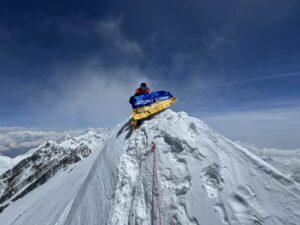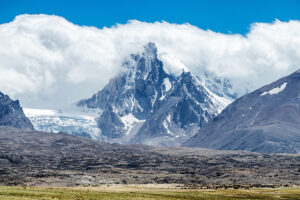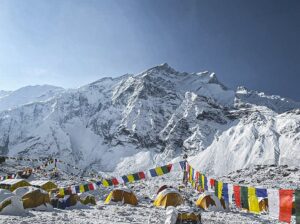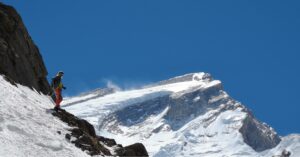In the last seven months, Nirmal Purja copped headlines as he sped from one 8,000’er to the next, finally completing all 14 in just over half a year. Despite some criticism over style, no one doubts that this was a physical, logistical and mental feat unprecedented in mountaineering history. But when he helped a Middle Eastern team drape Ama Dablam’s summit with a giant Kuwaiti flag, he crossed a line and now faces an unfamiliar reaction: disappointment.
One might think that, after finishing his project, a detailed report would top his agenda. In order to fully credit his accomplishment, we still need to see his summit photos, especially on Manaslu, where Purja and his team may have stopped some 20m — and a difficult ridge — short of the real summit.

Nirmal Purja on Ama Dablam. Photo: Facebook
Instead, immediately after Shishapangma, he hustled to Ama Dablam on a guiding gig. Among his clients, a team from Kuwait had a creative idea to honour their country’s national day: Under Purba’s leadership, they carried a 100m-by-30m flag weighing 150kgs, divided into six pieces, up to the summit and let it hang down from the otherwise sacred mountain. The highly visible display stunned climbers, trekkers and locals in the Khumbu Valley below.
Later, Purja’s team reported he had just accomplished “probably one of the most challenging and high-risk missions I have ever taken on the mountains.” As rumors spread, he confirmed his role in the giant flag affair, and posted some aerial footage on Twitter:
But when Alan Arnette reported the stunt and the comments piled up, Purja was forced to write an explanatory – and rather angry – post on Facebook yesterday. He said that they hung the flag only after all other climbers had descended, so no one’s summit was affected. They also carried the flag back down with them.
Purja claimed that the Kuwaitis — known by their Instagram handle, KFLAG Heroes — had hired 17 Sherpa guides, 4 kitchen staff and 20 porters, thus contributing to Nepal’s economy. He further argued that “everyone takes flags to the summit…Our flag was definitely bigger, but unlike many, we didn’t leave any traces up there.”
He concluded with a plea for people to focus on the positive aspect of things, to avoid drowning in negative energy.
In the last 24 hours, his post has solicited almost 200 comments. Interestingly enough, the first dozens were all positive — until someone noted that the negative ones were being deleted. Then criticism began to appear. Most of them decried putting politics and money over ethics, the lack of respect for locally revered mountains and that Nepal had not been asked for permission to hold such an event. Most potent, however, was the comment posted by Alexander Hillary (grandson of Sir Edmund), who happened to be in Base Camp at the time:

The Mani Rimdu Festival, celebrated at the Tengboche, Thame and Chiwong monasteries during the November full moon, is one of the most important religious festivities of Solukhumbu’s Sherpas.
The controversy seems to have caught Purja by surprise. It overshadowed his announcement that next spring, he intends to scout a new route up the Nepalese side of Cho Oyu. Allegedly, he wants to give future climbers a chance to climb the peak without having to wrangle with China’s demands, closures and deadlines, as he did. He is currently looking for potential clients (with one previous 8,000’er on their CVs) interested in joining the expedition.
Debate is open
Dangling a flag this size down a mountain face is in bad taste, but is it wrong? Is it reasonable to expect a business operator such as Purja, currently launching his Himalayan Elite guiding company, to refuse a juicy offer? How many others would have refused on ethical grounds? Was Nepal’s government unaware? Did the operation affect other teams on the mountain? Exactly how dangerous was this “high-risk mission” to the overloaded porters? Comments from climbers and trekkers who were at Ama Dablam at the time, as well as from other readers, would be most welcome.






